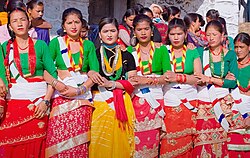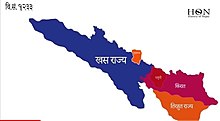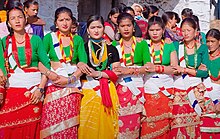Khas people
खस | |
|---|---|
 Khas women holding hands and performing Deuda | |
| Total population | |
| c. 15.3 million[1] | |
| Regions with significant populations | |
| Nepal, India, Bhutan | |
| Languages | |
| Nepali[2] | |
| Religion | |
| Hinduism | |
| Related ethnic groups | |
| Kumaoni, Garhwali, Pahari |

Khas tribe, (English:
According to the Constitution of Nepal, Bahun, Kshetris, Thakuris, and Sanyasis (Dashnami) who are citizens of Nepal should be considered as "Khas Arya" for electoral purposes.[13]
Origin
Indo-Aryan origin theories
They have been connected to the
Saka origin theories
Historian
History
Medieval history in Uttarakhand-Nepal

Khasas are believed to have arrived in the western reaches of Nepal at the beginning of first-millennium B.C.[33] or middle of first-millennium A.D.[34] from the north-west. The earliest linguistic evidences related to Nepali language also substantiates the linguistic intrusion of an Indo-Aryan speaking Khasa tribe from the West or Northwest Himalayas into Central Himalayas at the present day regions of Western Nepal.[18] It is likely that they absorbed people from different ethnic groups during this immigration.[35] They had extensively populated the mountainous regions of Uttarakhand[31] and they had entirely dominated the inner Himalayan belt up to Nepal.[36] Previously, Khashas had strongly established themselves from Afghanistan to Nepal from ancient period and as per internal evidences, they managed the village level theocratic republics like Gram-Rajya and Mandals under various local clans and identities.[31]
The ruling
History in Kashmir

The ruling
Modern history in Nepal
Until the 19th century, the Gorkhali referred to their country as Khas Desh (Khas country).[44] As they annexed the various neighboring countries (such as Nepal or Newa of the Newar people) to the Gorkha kingdom, the terms such as Khas and Newar ceased to be used as the names of countries. The 1854 legal code (Muluki Ain), promulgated by the Nepali Prime Minister Jung Bahadur Rana, himself a Khas,[45] no longer referred to Khas as a country, rather as a jāt (species or community) within the Gorkha kingdom.[46]


The
Jung Bahadur also re-labeled the Khas jāt as
Modern
Nepal
Modern-day Khas people are referred to as Hill Brahmin (Bahun), Hill Kshatriya (Thakuri/Chhetri) and Hill Dalit.[49] Further, historian Pokharel adds the Gharti, Damai, Kami, Sarki, Hudka, Tamote, Gaine and Badi to the Khas communities.[27] In modern times, Khas people are popularly referred by the term "Khas Arya".[3]
India-Pakistan
In
"..forms a very important links between the almost Hinduized Khasiyas of Kumaon and their brethren converts to Islam on the ethnical frontier of the mountains of Hindu Kush and apparently gives customs and practices of Khasiya race in full force at the present day which distinguished them thousands of years ago."[15]
Historian Sir
Communities
Historian Balkrishna Pokhrel writes the communities or caste in Khas group were hill
Historian-linguist E.T. Atkinson in his 1886 CE Kumaon gazetteer, mentions that there are 250 'septs among Khasiya Brahmins'[53] and 280 'septs among Khasiya Rajputs' who represent the Khasa tribe.[54] He states that the 90% of the Brahmins of Kumaon belong to the Khas tribe.[55] The Khasiya Brahmins are mentioned to have been chiefly cultivators and agriculturalists and most of them worship chiefly Bhairava, Shiva, Vishnu, the more common forms of the Shakti and village deities. Most of them derive their surnames from their village of origin.[53] The Khasiyas of Uttarakhand never attempted to connect themselves with plain regions until recently they found that such connections increases personal dignity.[56]
Khas people of the
Culture and religion
Languages
Irish Linguist
The Khas people of Nepal originally referred to their language as
Music
Deuda song and folk dance performed on the occasion of various festivals in the Sudurpashchim and Karnali provinces of Nepal.[59]

Religion
Majority of Khas profess Hinduism,some of them also follow Buddhism and some where also converted into Christianity. The Khas people too had their own religion known as Masto religion where 12 masto gods were worshipped these gods were said to be sons of
Notable people
Medieval Khas families and dynasties
- Katyuri kings[31]
- Lohara dynasty[16][40]
- Khas Malla rulers
- Gorkha kingdom
Modern Khas
- Bir Bhadra Thapa[60]
- Sanukaji Amar Singh Thapa[60]
- Bhimsen Thapa[60]
- Jung Bahadur Rana[45]
- Kalu Pande (Kaji) [60]
- BP Koirala
- Bhanubhakta Acharya
- Prithvi Narayan Shah
- Shivaram Singh Basnyat (Badabir senapanti) [61]
- Kehar Singh Basnyat
- Damodar Pandey
- Abhiman Singh Basnyat
- Kirtiman Singh Basnyat
- Bakhtawar Singh Basnyat
- Dhokal Singh Basnyat
- Rana Jang Pande
- Kunwar Inderjit Singh
- Subarna Shamsher Rana
- Sher Bahadur Thapa
- Surya Bahadur Thapa
- Jhalak Man Gandarbha
See also
Notes
- ^ Khas Arya is popularly used terminology over the various media to denote the group.[3][4][5][6][7][8][9][10][11][12] The Constitution of Nepal considers the Kshetris, Thakuris, and Sanyasis (Dashnami) as "Khas" for the electoral purposes.[13]
- Marc Aurel Stein further identified the modern Khakha Rajput community as the Khas people in the Azad Kashmir state of Pakistan[16] and the modern Bomba clan in the Karnah region of Jammu and Kashmir.[17]
References
- ^ "Nepali (npi)". Ethnologue. Retrieved 2016-10-06.
- ^ a b c Richard Burghart 1984, pp. 118–119.
- ^ a b Khadka, Suman (25 February 2015). "Drawing caste lines". The Kathmandu Post.
- ^ "Khas Arya quota provision in civil services opposed". thehimalayantimes.com. 10 November 2017. Retrieved 2018-05-01.
- ^ "Nepal's election may at last bring stability". The Economist. Retrieved 2018-05-01.
- ^ "PM briefs international community". The Kathmandu Post. Retrieved 2018-04-06.
- ^ "Quotable quota". Nepali Times. Retrieved 2018-05-01.
- ^ "Next Door Nepal: Another chink in the wall". indianexpress.com. 2 April 2018. Retrieved 2018-05-01.
- ^ "Oli in balancing avatar". myrepublica.com. Retrieved 2018-05-01.
- ^ "Nepal seeks unity from its first local elections in 20 years". Nikkei Asian Review. Retrieved 2018-05-01.
- ^ "Lessons for India From Nepal's History of Banning Cow Slaughter". The Wire. Retrieved 2018-05-01.
- ^ "What does high caste chauvinism look like?". The Kathmandu Post. 7 April 2018. Retrieved 2018-05-01.
- ^ a b "Part-8 Federal Legislature". Nepal Law Commission. Archived from the original on 2021-04-28. Retrieved 2019-08-05.
- ^ Hagen & Thapa 1998, p. 114.
- ^ a b c d e f Saksena 2019, p. 109.
- ^ a b c d e f Stein 1989, p. 433.
- ^ a b c d Stein 1989, p. 434.
- ^ a b c Jain & Cardona 2007, p. 543.
- ^ a b c Saklani 1998, p. 71.
- ^ a b William Brook Northey & C. J. Morris 1928, p. 123.
- ^ a b K. S. Singh 2005, p. 851.
- ^ a b c d Dor Bahadur Bista 1991, p. 48.
- ^ a b John T Hitchcock 1978, pp. 112–119.
- ^ Sharma 1999, p. 181.
- ^ a b c d Acharya 1975, p. 199.
- ^ Acharya 1975, p. 200.
- ^ a b c d e f g h Pokhrel 1973, p. 229.
- ^ Grierson 1916, p. 17.
- ^ Saksena 2019, pp. 108–109.
- ^ Grierson 1916, p. 3.
- ^ a b c d e f g h Handa 2002, p. 22.
- ^ Prasai, Dirgha Raj (27 February 2011). "History Of Nepali Language and its importance". Rising Nepal. Archived from the original on 2023-05-10. Retrieved 2022-11-30 – via Educatenepal.
- ^ Dor Bahadur Bista 1991, p. 15.
- ^ a b Sharma 1999, p. 112.
- ^ John T Hitchcock 1978, p. 113.
- ^ Handa 2002, p. 24-25.
- ^ Handa 2002, p. 24.
- ^ Handa 2002, pp. 26–28.
- ISBN 9780789207227. Archived from the original(PDF) on 2006-03-24. Retrieved 2016-06-14.
- ^ a b c d e Thakur 1990, p. 287.
- ^ Sharma 2019, p. 706.
- ^ Stein 1989, p. 432.
- ^ Stein 1989, p. 16.
- ^ a b Richard Burghart 1984, p. 107.
- ^ a b Dor Bahadur Bista 1991, p. 37.
- ^ Richard Burghart 1984, p. 117.
- ^ a b Richard Burghart 1984, p. 119.
- ^ Susan Thieme 2006, p. 83.
- ^ John T Hitchcock 1978, pp. 116–119.
- ^ a b c Manorma Sharma 1998, p. 113.
- ^ Sannyasi
- ^ a b c Whelpton 2005, p. 31.
- ^ a b Crooke 1896, p. 253.
- ^ von Fürer-Haimendorf 1966, p. 189.
- ^ Crooke 1896, p. 254.
- ^ Crooke 1896, p. 255.
- ^ Saksena 2019, pp. 107, 109–111.
- ^ Richard Burghart 1984, p. 118.
- ^ "देउडा गीत र देउडा भाषिकाको इतिहास". Sajha Bisaunee (in Nepali). Retrieved 2023-05-08.
- ^ a b c d Pradhan 2012, p. 22.
- ISBN 978-0-429-22460-7, retrieved 2021-07-02
Bibliography
- Acharya, Baburam (1975), Bhandari, Devi Prasad (ed.), "Itihas Kaalbhanda Pahile" (PDF), Purnima, 8 (1), Kathmandu
- Adhikary, Surya Mani (1997). The Khaśa kingdom: a trans-Himalayan empire of the middle age. Nirala. ISBN 978-81-85693-50-7.
- Crooke, William (1896), The Tribes and Castes of the North-western Provinces and Oudh, Volume 3, Calcutta: Office of the Superintendent of Government Printing India
- D.R. Regmi (1965), Medieval Nepal, vol. 1, Firma K.L. Mukhopadhyay
- ISBN 978-81-250-0188-1.
- Grierson, George Abraham (1916). Linguistic Survey of India, Volume 9, Part 4. Vol. 9. Office of the superintendent of government printing, India.
- Hagen, Toni; Thapa, Deepak (1998). Toni Hagen's Nepal: The Kingdom in the Himalaya. Himal Books.
- John T Hitchcock (1978). "An Additional Perspective on the Nepali Caste System". In James F. Fisher (ed.). Himalayan Anthropology: The Indo-Tibetan Interface. Walter de Gruyter. ISBN 978-90-279-7700-7.
- K. S. Singh (2005). People of India: Uttar Pradesh. Anthropological Survey of India. ISBN 978-81-7304-114-3.
- Pokhrel, Balkrishna (1 December 1973) [1962], "Ancient Khas Culture" (PDF), Regmi Research Series, 5 (12): 229–236
- Pradhan, Kumar L. (2012), Thapa Politics in Nepal: With Special Reference to Bhim Sen Thapa, 1806–1839, New Delhi: Concept Publishing Company, p. 278, ISBN 9788180698132
- Richard Burghart (1984). "The Formation of the Concept of Nation-State in Nepal". The Journal of Asian Studies. 44 (1): 101–125. S2CID 154584368.
- Susan Thieme (2006). Social Networks and Migration: Far West Nepalese Labour Migrants in Delhi. LIT Verlag Münster. ISBN 978-3-8258-9246-3.
- William Brook Northey; C. J. Morris (1928). The Gurkhas: Their Manners, Customs, and Country. Asian Educational Services. ISBN 978-81-206-1577-9.
- Whelpton, John (2005). A History of Nepal. Cambridge University Press. ISBN 978-0521804707.
- Sharma, Bal Krishna (1999). The origin of caste system in Hinduism and its relevance in the present context. Indian Society for Promoting Christian Knowledge and Samdan Publishers. ISBN 9788172144968.
- Handa, O. C. (Omacanda) (2002). History of Uttaranchal. New Delhi: Indus Publishing. ISBN 9788173871344.
- Jain, Danesh; Cardona, George (26 July 2007). The Indo-Aryan Languages. Routledge. ISBN 9781135797119.
- Saklani, Dinesh Prasad (1998). Ancient Communities of the Himalaya. Indus Publishing. ISBN 9788173870903.
- Saksena, R.N. (2019). "Marriages and Family in the Polyandrous Khasa tribe of Jaunsar-Bawar". In George Kurrian (ed.). The Family in India: A Regional View. Walter de Gruyter GmbH & Co. pp. 108–118. ISBN 9783110886757.
- Manorma Sharma (1998). Tribal Melodies of Himachal Pradesh: Gaddi folk music. APH Publishing. ISBN 9788170249122.
- Sharma, Megha (2019), "The region of Kashmir in Ancient Literature with special mention to Tribes" (PDF), Pramana Research Journal, 9 (6): 703–707, ISSN 2249-2976
- Stein, Marc Aurel (1979) [1900a]. "Chronological and Dynastic Tables of Kalhana's Record of Kasmir Kings". Kalhana's Rajatarangini: A Chronicle of the Kings of Kasmir. Vol. 1. Motilal Banarsidass.
- Stein, Mark Aurel (1989) [1900]. Kalhana's Rajatarangini: a chronicle of the kings of Kasmir, Volume 2 (Reprinted ed.). Motilal Banarsidass. ISBN 978-81-208-0370-1. Retrieved 2011-07-10.
- Thakur, Laxman S. (1990). "The Khasas An Early Indian Tribe". In K. K. Kusuman (ed.). A Panorama of Indian Culture: Professor A. Sreedhara Menon Felicitation Volume. Mittal Publications. pp. 285–293. ISBN 978-81-7099-214-1.
- Tucci, Giuseppe (1956), Preliminary Report on Two Scientific Expeditions in Nepal, David Brown Book Company, ISBN 9788857526843
- von Fürer-Haimendorf, Christoph (1966), Caste and Kin in Nepal, India and Ceylon: Anthropological Studies in Hindu-Buddhist Contact Zones, Asia Publishing House
